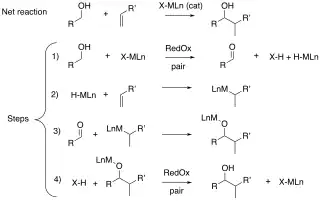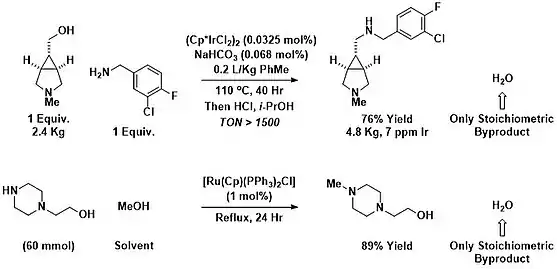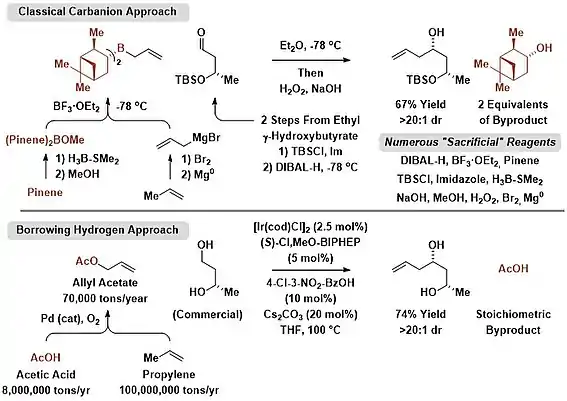Hydrogen auto-transfer
Hydrogen auto-transfer, also known as borrowing hydrogen, is the activation of a chemical reaction by temporary transfer of two hydrogen atoms from the reactant to a catalyst and return of those hydrogen atoms back to a reaction intermediate to form the final product.[1][2][3][4] Two major classes of borrowing hydrogen reactions exist: (a) those that result in hydroxyl substitution,[1][2] and (b) those that result in carbonyl addition.[3][4] In the former case, alcohol dehydrogenation generates a transient carbonyl compound that is subject to condensation followed by the return of hydrogen. In the latter case, alcohol dehydrogenation is followed by reductive generation of a nucleophile, which triggers carbonyl addition. As borrowing hydrogen processes avoid manipulations otherwise required for discrete alcohol oxidation and the use of stoichiometric organometallic reagents, they typically display high levels of atom-economy and, hence, are viewed as examples of Green chemistry.

History
The Guerbet reaction, reported in 1899,[5] is an early example of a hydrogen auto-transfer process. The Guerbet reaction converts primary alcohols to β-alkylated dimers via alcohol dehydrogenation followed by aldol condensation and reduction of the resulting enones. Application of the Guerbet reaction to the development of ethanol-to-butanol processes has garnered interest as a method for the production of renewable fuels.[6] In 1932 using heterogeneous nickel-catalysts Adkins reported the first alcohol aminations that occur through alcohol dehydrogenation-reductive amination.[7] Homogenous catalysts for alcohol amination based on rhodium and ruthenium were developed by Grigg[8] and Watanabe[9] in 1981. The first hydrogen auto-transfer processes that convert primary alcohols to products of carbonyl addition were reported by Michael J. Krische in 2007-2008 using homogenous iridium and ruthenium catalysts.[10][11][12]
Hydroxyl substitution
Alcohol aminations are among the most commonly utilized borrowing hydrogen processes.[13][14][15] In reactions of this type, alcohol dehydrogenation is followed by reductive amination of the resulting carbonyl compound. This represents an alternative to two-step processes involving conversion of the alcohol to a halide or sulfonate ester followed by nucleophilic substitution
As shown below, alcohol amination has been used on kilogram scale by Pfizer for the synthesis of advanced pharmaceutical intermediates.[16] Additionally, AstraZeneca has used methanol as an alternative to conventional genotoxic methylating agents such as methyl iodide or dimethyl sulfate.[17] Nitroaromatics can also participate as amine precursors in borrowing hydrogen-type alcohol aminations.[18]

The formation of carbon–carbon bond has been achieved through borrowing hydrogen-type Indirect witting,[19] aldol,[20] Knoevenagel condensation [21] and also through various carbon nucleophiles.[22][23] Related to the Guerbet reaction, Donohoe and coworkers have developed enantioselective borrowing hydrogen-type enolate alkylations.[24]
Carbonyl addition
As exemplified by the Krische allylation, dehydrogenation of alcohol reactants can be balanced by reduction of allenes, dienes or allyl acetate to generate allylmetal-carbonyl pairs that combine to give products of carbonyl addition.[3][4] In this way, lower alcohols are directly transformed to higher alcohols in a manner that significantly decreases waste.[25]

In 2008, borrowing hydrogen reactions of 1,3-enynes with alcohols to form products of carbonyl propargylation was discovered.[26] An enantioselective variant of this method was recently used in the total synthesis of leiodermatolide A.[27]

References
- Hamid MH, Slatford PA, Williams JM (2007). "Borrowing Hydrogen in the Activation of Alcohols". Advanced Synthesis & Catalysis. 349 (10): 1555–1575. doi:10.1002/adsc.200600638.
- Guillena G, Ramón DJ, Yus M (2007-03-26). "Alcohols as electrophiles in C--C bond-forming reactions: the hydrogen autotransfer process". Angewandte Chemie. 46 (14): 2358–64. doi:10.1002/anie.200603794. PMID 17465397.
- Ketcham JM, Shin I, Montgomery TP, Krische MJ (August 2014). "Catalytic enantioselective C-H functionalization of alcohols by redox-triggered carbonyl addition: borrowing hydrogen, returning carbon". Angewandte Chemie. 53 (35): 9142–50. doi:10.1002/anie.201403873. PMC 4150357. PMID 25056771.
- Nguyen KD, Park BY, Luong T, Sato H, Garza VJ, Krische MJ (October 2016). "Metal-catalyzed reductive coupling of olefin-derived nucleophiles: Reinventing carbonyl addition". Science. 354 (6310): aah5133. doi:10.1126/science.aah5133. PMC 5130112. PMID 27846504.
- Guerbet M (1899). "Action de l'Alcool Amylique de Fermentation sur Son Dérivé Sodé" [Action of Amyl Alcohol Fermentation on Its Soda Derivative]. Comptes rendus de l'Académie des Sciences (in French). Paris. 128: 1002–1004.
- Aitchison H, Wingad RL, Wass DF (2016-10-07). "Homogeneous Ethanol to Butanol Catalysis—Guerbet Renewed" (PDF). ACS Catalysis. 6 (10): 7125–7132. doi:10.1021/acscatal.6b01883. S2CID 53363379.
- Winans CF, Adkins H (1932-01-01). "The alkylation of amines as catalyzed by nickel". Journal of the American Chemical Society. 54 (1): 306–312. doi:10.1021/ja01340a046. ISSN 0002-7863.
- Grigg R, Mitchell TR, Sutthivaiyakit S, Tongpenyai N (1981-01-01). "Transition metal-catalysed N-alkylation of amines by alcohols". Journal of the Chemical Society, Chemical Communications (12): 611–612. doi:10.1039/C39810000611. ISSN 0022-4936.
- Watanabe, Yoshihisa; Tsuji, Yasushi; Ohsugi, Yukihiro (1981-01-01). "The ruthenium catalyzed N-alkylation and N-heterocyclization of aniline using alcohols and aldehydes". Tetrahedron Letters. 22 (28): 2667–2670. doi:10.1016/S0040-4039(01)92965-X. ISSN 0040-4039.
- Bower JF, Skucas E, Patman RL, Krische MJ (December 2007). "Catalytic C-C coupling via transfer hydrogenation: reverse prenylation, crotylation, and allylation from the alcohol or aldehyde oxidation level". Journal of the American Chemical Society. 129 (49): 15134–5. doi:10.1021/ja077389b. PMID 18020342.
- Shibahara F, Bower JF, Krische MJ (May 2008). "Ruthenium-catalyzed C-C bond forming transfer hydrogenation: carbonyl allylation from the alcohol or aldehyde oxidation level employing acyclic 1,3-dienes as surrogates to preformed allyl metal reagents". Journal of the American Chemical Society. 130 (20): 6338–9. doi:10.1021/ja801213x. PMC 2842574. PMID 18444617.
- Kim IS, Ngai MY, Krische MJ (May 2008). "Enantioselective iridium-catalyzed carbonyl allylation from the alcohol or aldehyde oxidation level using allyl acetate as an allyl metal surrogate". Journal of the American Chemical Society. 130 (20): 6340–1. doi:10.1021/ja802001b. PMC 2858451. PMID 18444616.
- Hamid MH, Slatford PA, Williams JM (2011). "The Catalytic Amination of Alcohols". ChemCatChem. 3 (12): 1853–1864. doi:10.1002/cctc.201100255. ISSN 1867-3899. S2CID 38816793.
- Yang Q, Wang Q, Yu Z (April 2015). "Substitution of alcohols by N-nucleophiles via transition metal-catalyzed dehydrogenation". Chemical Society Reviews. 44 (8): 2305–29. doi:10.1039/C4CS00496E. PMID 25661436.
- Das, Kuhali; Kumar, Amol; Jana, Akash; Maji, Biplab (2020-03-01). "Synthesis and characterization of N,N-chelate manganese complexes and applications in CN coupling reactions". Inorganica Chimica Acta. 502: 119358. doi:10.1016/j.ica.2019.119358. ISSN 0020-1693. S2CID 214558556.
- Berliner MA, Dubant SP, Makowski T, Ng K, Sitter B, Wager C, Zhang Y (2011-09-16). "Use of an Iridium-Catalyzed Redox-Neutral Alcohol-Amine Coupling on Kilogram Scale for the Synthesis of a GlyT1 Inhibitor". Organic Process Research & Development. 15 (5): 1052–1062. doi:10.1021/op200174k. ISSN 1083-6160.
- Leonard J, Blacker AJ, Marsden SP, Jones MF, Mulholland KR, Newton R (2015-10-16). "A Survey of the Borrowing Hydrogen Approach to the Synthesis of some Pharmaceutically Relevant Intermediates" (PDF). Organic Process Research & Development. 19 (10): 1400–1410. doi:10.1021/acs.oprd.5b00199. ISSN 1083-6160.
- Rubio-Marqués P, Leyva-Pérez A, Corma A (September 2013). "A bifunctional palladium/acid solid catalyst performs the direct synthesis of cyclohexylanilines and dicyclohexylamines from nitrobenzenes". Chemical Communications. 49 (74): 8160–2. doi:10.1039/c3cc44064h. hdl:10251/45848. PMID 23925659.
- Black, Phillip J.; Edwards, Michael G.; Williams, Jonathan M. J. (2006). "Borrowing Hydrogen: Indirect "Wittig" Olefination for the Formation of C–C Bonds from Alcohols". European Journal of Organic Chemistry. 2006 (19): 4367–4378. doi:10.1002/ejoc.200600070. ISSN 1099-0690.
- Taguchi, Kazuhiko; Nakagawa, Hideto; Hirabayashi, Tomotaka; Sakaguchi, Satoshi; Ishii, Yasutaka (2004-01-01). "An Efficient Direct α-Alkylation of Ketones with Primary Alcohols Catalyzed by [Ir(cod)Cl]2/PPh3/KOH System without Solvent". Journal of the American Chemical Society. 126 (1): 72–73. doi:10.1021/ja037552c. ISSN 0002-7863.
- Pridmore S, Williams JM (December 2008). "C–C bond formation from alcohols and malonate half esters using borrowing hydrogen methodology". Tetrahedron Letters. 49 (52): 7413–7415. doi:10.1016/j.tetlet.2008.10.059.
- Blank, Benoît; Kempe, Rhett (2010-01-27). "Catalytic Alkylation of Methyl-N-Heteroaromatics with Alcohols". Journal of the American Chemical Society. 132 (3): 924–925. doi:10.1021/ja9095413. ISSN 0002-7863. PMID 20047316.
- Jana, Akash; Kumar, Amol; Maji, Biplab (2021). "Manganese catalyzed C-alkylation of methyl N -heteroarenes with primary alcohols". Chemical Communications. 57 (24): 3026–3029. doi:10.1039/D1CC00181G. ISSN 1359-7345. PMID 33624678. S2CID 232037523.
- Armstrong RJ, Akhtar WM, Young TA, Duarte F, Donohoe TJ (September 2019). "Catalytic Asymmetric Synthesis of Cyclohexanes by Hydrogen Borrowing Annulations". Angewandte Chemie. 58 (36): 12558–12562. doi:10.1002/anie.201907514. PMC 6771629. PMID 31265208.
- Doerksen RS, Meyer CC, Krische MJ (October 2019). "Feedstock Reagents in Metal-Catalyzed Carbonyl Reductive Coupling: Minimizing Preactivation for Efficiency in Target-Oriented Synthesis". Angewandte Chemie. 58 (40): 14055–14064. doi:10.1002/anie.201905532. PMC 6764920. PMID 31162793.
- Patman RL, Williams VM, Bower JF, Krische MJ (2008). "Carbonyl propargylation from the alcohol or aldehyde oxidation level employing 1,3-enynes as surrogates to preformed allenylmetal reagents: a ruthenium-catalyzed C-C bond-forming transfer hydrogenation". Angewandte Chemie. 47 (28): 5220–3. doi:10.1002/anie.200801359. PMC 2861420. PMID 18528831.
- Siu YM, Roane J, Krische MJ (July 2021). "Total Synthesis of Leiodermatolide A via Transfer Hydrogenative Allylation, Crotylation, and Propargylation: Polyketide Construction beyond Discrete Allyl- or Allenylmetal Reagents". Journal of the American Chemical Society. 143 (28): 10590–10595. doi:10.1021/jacs.1c06062. PMC 8529965. PMID 34237219.